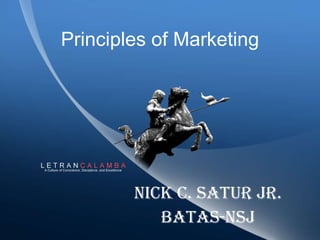Mktg 1 Mdterms
- 1. Principles of Marketing NICK C. SATUR JR. BATAS-NSJ
- 2. What is a Product? A product is anything that can be offered to a market for attention, acquisition, use, or consumption and that might satisfy a want or need. Includes: Physical Objects Services Events Persons Places Organizations Ideas
- 4. Product Hierarchy Product needŌĆöthe core need that underlies the existence of a product family. To satisfy a need e.g. feet protection Product classŌĆöa family of products having similar function e.g. all shoes Product lineŌĆöa group of products with closely related functions e.g. sports shoes Product typeŌĆöproducts within a line having similar form e.g. basket-ball shoes BrandŌĆöa name representing a product or line e.g. Nike Item (Stock Keeping Unit)ŌĆöa unit item e.g. one pair of Nike basket-ball shoe
- 5. Product Classification Durability Use Tangibility
- 6. Durability and Tangibility Nondurable goods Services Durable goods
- 7. Durable goods Are tangible goods that normally survive many uses. Durables have long intervals of repeat purchase. Non Durables - Repeat purchase is usually strong.These are tangible goods normally consumed in one or few uses
- 8. Services - Are intangible,inseperable variable, and perishable products that do not result to the ownership of anything.
- 9. Consumer Goods Classification The vast array of goods consumers buy can be classified on the basis of shopping habits.
- 10. Convenience Goods Are those that customer ussually purchases frequently, immediately and with a minimum of effort. Lowest risk, lowest effort Ex. Soap, tobacco
- 11. Shopping Goods Are goods that the customer, in the process of selection and purchase, characteristically compares on such basis as suitability,price, quality and style. Ex. Clothings, used cars, furnitures
- 12. Specialty Goods Goods that have a unique characteristics or brand identification for which a sufficient number of buyers is willing to make a special purchasing effort. Ex Mercedes, paintings by known artists,
- 13. Unsought Goods Those that the consumer does not know about or does not normally think of buying.
- 14. Consumer Goods Classification Convenience Unsought Shopping Specialty
- 15. USE Industrial Goods Classification These goods can be classified by how they enter the production process and their relative costliness. Materials & Parts Capital Items Supplies and Business Services
- 16. 2 Classes of Materials & Parts Raw Materials Natural Products Farm Products Manufactured material parts Component Parts-Enter the finished product with no further change in form Component Materials-fabricated Further ex iron
- 17. Supplies and Business Services Are short-lasting goods and services that facilitate, developing or managing the finished product.
- 18. Supplies Maintenance & Repair Items Operating Supplies
- 19. Business Service Maintenance & Repair Services Business Advisory Services
- 20. Definition of New Products 1. Products new to the world; usually revolutionary products resulting from product innovation e.g When Creative Technology first introduced the Sound-blaster When disposable cameras were first introduced When Seiko introduced the Seiko Kinetic Relay, a watch that can go into suspended animation
- 21. 2. New Product Lines 3. Improvements to existing products e.g. In 1960 Kao introduced shampoo liquid and in 1970 introduced Kao Merit shampoo (anti-dandruff) 4. Additions to existing lines e.g. In 1965 Kao introduced the Kao Tender hair conditioner 5. Costs reductions 6. re-positionings
- 22. Product Mix Product Assortment Set of all products and Items that a particular seller offers for sale.
- 23. Marketing Mix
- 24. ╠²
- 25. New Product Development Process Idea Generation Concept Development and Testing Marketing Strategy Development Idea Screening Business Analysis Product Development Market Testing Commercialization
- 26. Step 1. Idea Generation Idea Generation is the Systematic Search for New Product Ideas Obtained Internally From Employees and Also From: Customers Competitors Distributors Suppliers
- 27. Idea Screening Process to spot good ideas and drop poor ones as soon as possible. Many companies have systems for rating and screening ideas which estimate: Market Size Product Price Development Time & Costs Unit Costs Rate of Return Then, the idea is evaluated against a set of general company criteria.
- 28. New Product Development Process Step 3. Concept Development 1. Develop New Product Ideas into Alternative Detailed Product Concepts 2. Concept Testing - Test the New Product Concepts with Groups of Target Customers 3. Choose the One That Has the Strongest Appeal to Target Customers
- 29. Step 4. Marketing Strategy Part Three Describes Long-Term: Sales & Profit Goals Marketing Mix Strategy Part Two Describes First-Year: ProductŌĆÖs Planned Price Distribution Marketing Budget Part One Describes Overall: Target Market Planned Product Positioning Sales & Profit Goals Market Share
- 30. Step 5. Business Analysis Step 6. Product Development If No, Eliminate Product Concept Business Analysis Review of Product Sales, Costs, and Profits Projections to See if They Meet Company Objectives If Yes, Move to Product Development
- 31. Step 7. Test Marketing Test Marketing is the Stage Where the Product and Marketing Program are Introduced into More Realistic Market Settings. Elements that May be Test Marketed by a Company Advertising Atmosphere Product Budget Levels Positioning Location Pricing Branding
- 32. Step 8. Commercialization Commercialization is the Introduction of the New Product into the Marketplace. When is the Right Time to Introduce Product? Where to Launch a New Product?
- 33. ╠²

































